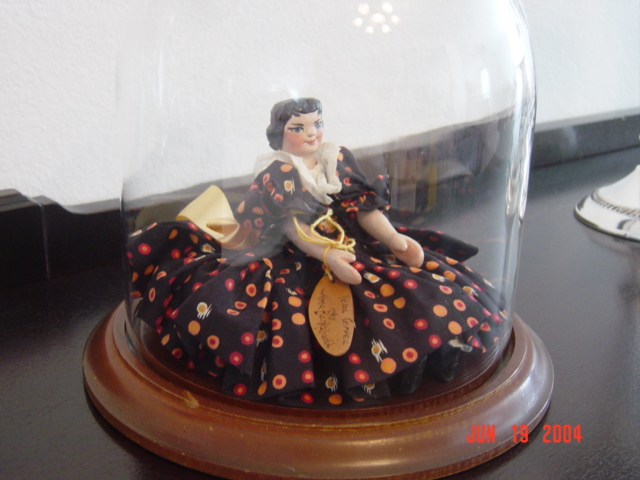|
|
|
|
|
|
|
|
|
|
|
|
|
|
|
|
 |
Do You Know This Hitty?
Her Owner, Nancy Weary, would appreciate anything
known about this Hitty and her carver.
If you have any info, you can send it to
us at the research pages by clicking this link.
If you have a Hitty carved by Alma Barkshadhl we would love to see it!
Known Info:
Nancy inherited this Hitty Doll. It was given to Nancy in the 1930's by her great-aunt, a librarian in Greenville South Carolina, along with the book "Hitty, her First Hundred Years". The inscription from her great-aunt to Nancy is legible, although the book is in poor condition. Tthe doll is in very good condition, resembling the original Hitty doll to a tee, including the outfit from what Nancy has been able to see from the original's pictures. There is a wooden "tag" around her wrist that reads "Hand Carved by Alma Barkshadl".
|
|
|
|
|
|
|
|
|
|
|
|
|
|
|
|
 |
If you have any info, you can send it to us at the research pages by clicking this link.
The artist was Alma Barkshadt who was born 13 June 1903.
Her parents were Charles Barkshadt who was born in Germany and made his living
as a tailor,
and Rosa, who was born in Tennessee to German and Swiss parents. The family
lived in Greenville, SC, where Alma was born, and Alma was a
well-known local "character artist". She died in Greenville in Feb
1984.
Here are some interesting things about Alma that I found in two websites about the Georgia artist Otto Waldrop:
Otto Waldrop, Georgia artist
"My association with wood came early
in childhood. I was raised by my
grandparents in Greenville, SC. My grandfather owned and operated a
millwork (doors, windows, mantels, etc) shop, so my love of the feel and
smell of newly worked wood is a deep-seated passion.
My grandfather was a classic "whittler"
who taught me the way to work
with the wood so as to bring out the beauty and grace of the natural wood
grain. He also taught me to use band-aids, how to remove splinters and the
use of an awful smelling potion called "Pine Oil."
(It really worked
to remove soreness and swelling!)"
Otto's mother and grandmother saw
a talent for art and arranged for him
to study under a local "character-artist"
named Alma Barkshadt. He
studied oil, pen and ink and pastels under "Miss Alma"
for six years
until he entered his "teen years and began to pursue other
interests for
awhile (cars, girls and such)". During his years in the United
States
Navy, Otto found that oil painting as a hobby while in the service
wasn't very practical. He began picking up scrap pieces of
wood in the
shipyards to carve as a pastime. He learned to blend the manual dexterity
and love of wood that his grandfather imparted, with the eye for form and
creativity that Miss Alma fostered, into the style that he has today. Otto
studied sculpture under Phillip Wheatley (resident sculptor of the
Greenville Art Museum) and produced a number of bronze castings using the
"lost-wax" process. "The
creation of the wax piece, the venting
process, mixing of Ludo (investment), bake-out and finally the actual
pouring was one of the most fascinating experiences that I have yet to go
through."
Otto creates his pieces from wood that he has collected
from the forest
floor. Any exotic woods needed are purchased only from reputable dealers
who follow forest management procedures. He uses tupelo-gum for the
animal, fish and bird sculptures and local woods for the "interpretive
pieces" (walnut, maple, cedar, dogwood, etc.). He is an active
member
and past-president of The Atlanta Wood Carvers Club, a member of the
National Wood Carvers Association, the Southeastern Wood Carvers and the
Gwinnett Council for the Arts. "I sincerely hope that the
owners of my
creations enjoy them as much as I enjoyed being the vehicle for their
emergence from the wood."
******************************************************************
Biographical Sketch of Otto Waldrop
Seen to have a talent for art, Otto studied under a
local
"character-artist" who would become his
teacher and mentor. Her name
was Alma Barkshadt. She believed in only using the basic colors; anything
else was to be mixed by the artist. Otto didn't anticipate
Miss Alma's
reaction when she discovered him sneaking into class with a tube of an
exceptionally pretty premixed color. She took the tube away from him and
promptly threw it out of the studio's third floor window,
into Main
Street. Being a quick study, Otto never attempted that again.
Every time he saw Miss Alma she would ask what he was
currently working
on. When he replied "Nothing," she would
show her true German blood
and scold him severely. Next, Otto spent a few years in he United States
Navy. Oil-painting as a hobby during this time turned out to be
impractical. But scrap pieces of wood were abundant in the shipyards, just
waiting to be carved. Soon, he was able to blend the manual dexterity and
love of wood that his grandfather imparted with the eye for form and
creativity, which Miss Alma fostered, into the style that you see in his
work today. After the Navy, Otto studied sculpture under Philip Wheatley,
the resident sculptor of the Greenville Art Museum. Together, they
produced a number of bronze castings using the "lost-wax"
process.
Today, Otto creates wood art from pieces that he gleans from the forest
floor. When in need of an exotic species, he purchases only from reputable
dealers who follow sound forest management procedures. He prefers
Tupelo-gum for animal, fish and bird sculptures. For interpretive pieces
(artistic forms and realistic sculpture), any local wood such as walnut,
maple, cedar, dogwood, etc. will do. .
Ann S.